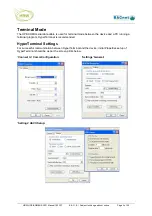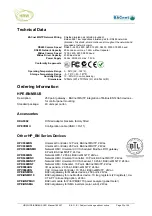
HRW HPE-BNMBUS V401 Manual 180307 E. & O. E. / Subject to change without notice
Page 10 of 24
Gateway Data Base Structure
Gateway Point Types
Each point (AV4…253) must be configured to access the relevant M-Bus network device and data
registers within the device. The points are grouped starting with a meter address point followed by a
subset of data points associated with the preceding meter addressing point.
Point configurations always end with code lettering which indicate whether the point is an addressing
point, a data point, a data point extension (additional four bytes of data needed for the preceding point
address) and whether the reading is periodical as opposed to continuous.
HPE-BNMBUS Point Type
End Code
Description
Meter ID No. with AV active
…M
Indicates that the point config string is defining a
Meter address with the common ‘DVIF’ data point
result assigned to the associated gateway AV
Meter ID No. AV inactive
…A
Indicates that the point config string is defining a
meter Address only, without the ‘DVIF’ data point
result assigned to the associated gateway AV
Data Point
…D
Indicates that the point config string is defining a
data point with in the previous meter address
location
Data Extension Point
…X
Indicates that the point config string is a data
capacity extension to the previous point. Any point
with more than 4 bytes of data will require an X
point added for every additional 4 data bytes
Timed Scan point
…_T
When appended to M, A, D or X types above,
indicates that the point will be periodically
scanned according to the TS setting
(recommended)
Common DVIF
To enable the meter addressing point to also act as a data gathering point there is a common global
point configuration available, the DVIF, the read value of which will be applied to all gateway points (AV)
that have end code M.
Gateway Point Type
Global Point
Description
Data Point common to all M
points
DVIF=…
Sets the data point address to read for every point
configured as a meter address point (M)
The DVIF should be the first required point as it appears in the M-Bus device’s RSP pages and ideally it
should be possible to define it using DIF value only. If VIF must be used to avoid reading an
sequentially earlier value which is not needed but which has identical DIF, the VIF should be identical
for all of the devices on the network, i.e., it should not be a value who’s VIF changes from device to
device due to differing data resolution in the device.
If it is not possible to find a data point that meets the above criteria then assign M end code to those
meter address points which most commonly have the same DIF/VIF but assign A end code to those
meter address points which have the same DIF but different VIF. The AV of the meter address points
with A end code assigned will become redundant and the required DIF/VIF setting in those cases
should be applied to the first available AV following the their address point.










































